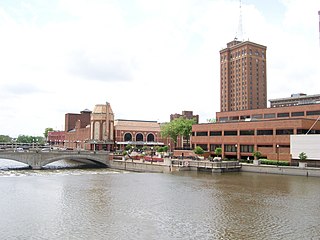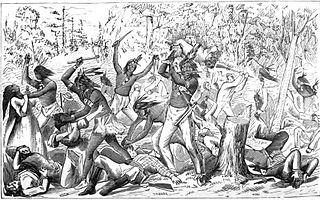
Jean Baptiste Point du Sable is regarded as the first permanent non-Indigenous settler of what later became Chicago, Illinois, and is recognized as the "Founder of Chicago". A school, museum, harbor, park, and bridge have been named in his honor. The site where he settled near the mouth of the Chicago River around the 1780s is identified as a National Historic Landmark, now located in Pioneer Court.

The Battle of Fort Dearborn was an engagement between United States troops and Potawatomi Native Americans that occurred on August 15, 1812, near Fort Dearborn in what is now Chicago, Illinois. The battle, which occurred during the War of 1812, immediately followed the evacuation of the fort as ordered by the commander of the United States Army of the Northwest, William Hull. The battle lasted about 15 minutes and resulted in a complete victory for the Native Americans. After the battle, Fort Dearborn was burned down. Some of the soldiers and settlers who had been taken captive were later ransomed.

Fort Dearborn was a United States fort built in 1803 beside the Chicago River, in what is now Chicago, Illinois. It was constructed by troops under Captain John Whistler and named in honor of Henry Dearborn, then United States Secretary of War. The original fort was destroyed following the Battle of Fort Dearborn during the War of 1812, and a new fort was constructed on the same site in 1816. By 1837, the fort had been de-commissioned. Parts of the fort were lost to both the widening of the Chicago River in 1855, and a fire in 1857. The last vestiges of Fort Dearborn were destroyed in the Great Chicago Fire of 1871. The site of the fort is now a Chicago Landmark, located in the Michigan–Wacker Historic District.

Black Hawk, born Ma-ka-tai-me-she-kia-kiak, was a band leader and warrior of the Sauk American Indian tribe in what is now the Midwest of the United States. Although he had inherited an important historic sacred bundle from his father, he was not a hereditary civil chief. Black Hawk earned his status as a war chief or captain by his actions: leading raiding and war parties as a young man, and a band of Sauk warriors during the Black Hawk War of 1832.
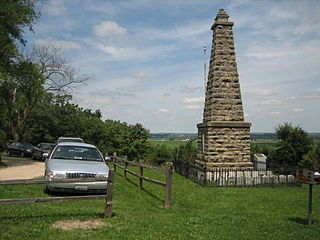
The Battle of Kellogg's Grove is either of two minor battles, or skirmishes, fought during the Black Hawk War in U.S. state of Illinois, in present-day Stephenson County at and near Kellogg's Grove. In the first skirmish, also known as the Battle of Burr Oak Grove, on June 16, 1832, Illinois militia forces fought against a band of at least 80 of Native Americans. During the battle three militia men under the command of Adam W. Snyder were killed in action. The second battle occurred nine days later when a larger Sauk and Fox band, under the command of Black Hawk, attacked Major John Dement's detachment and killed five militia men.
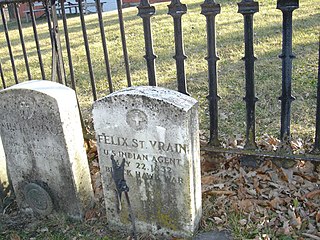
The St. Vrain massacre was an incident in the Black Hawk War. It occurred near present-day Pearl City, Illinois, in Kellogg's Grove, on May 24, 1832. The massacre was most likely committed by Ho-Chunk warriors who were unaffiliated with Black Hawk's band of warriors. It is also unlikely that the group of Ho-Chunk had the sanction of their nation. Killed in the massacre were United States Indian Agent Felix St. Vrain and three of his companions. Some accounts reported that St. Vrain's body was mutilated.

Sunbury Township is located in Livingston County, Illinois. As of the 2010 census, its population was 229 and it contained 103 housing units. Contains 1,035 square miles of territory.
John Murray was a laborer, music teacher, soldier, businessman, politician, and city planner, was one of the original founders of Naperville, Illinois, with his children Sarah, Robert Nelson, Ruth, Amos and Cordelia. He was married to Joseph Naper's sister, Amy Naper.
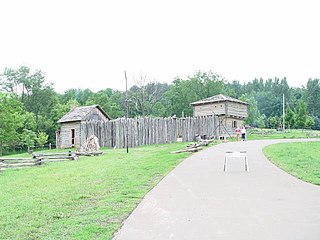
The Battle of Apple River Fort, occurred on the late afternoon of June 24, 1832 at the Apple River Fort, near present-day Elizabeth, Illinois, when Black Hawk and 200 of his "British Band" of Sauk and Fox were surprised by a group of four messengers en route from Galena, Illinois. One of the couriers was wounded in the thigh as the riders quickly made for the protection of the nearby stockade. Courier Fred Dixon rode ahead to warn some 70 settlers of the approaching Sauk and Fox, thus saving their lives.The small company of militia at the fort, about 28-30 men and boys led by Captain Clack Stone, fought off Black Hawk's 150-man war party in an action that lasted about an hour. The withering pace of the gunfire eventually convinced Black Hawk that the fort was too heavily defended to lead a direct attack. He considered burning the fort, then switched to raiding cabins of foodstuffs, clothing and cooking utensils. In the gathering darkness, Black Hawk and his war party retreated.

Shabbona, also known as Shabonee and Shaubena, was an Ottawa tribe member who became a chief within the Potawatomi tribe in Illinois during the 19th century.
The Sinsinawa Mound raid occurred on June 29, 1832, near the Sinsinawa mining settlement in Michigan Territory. This incident, part of the Black Hawk War, resulted in the deaths of two men; a third man survived by seeking cover in a nearby blockhouse. In the aftermath of the raid, Captain James W. Stephenson set out to pursue the attackers—a straggling band of Sauk Native Americans—but lost their trail at the Mississippi River. The attack occurred in the same week as other skirmishes and raids, and as a result helped contribute to the growing fear in the region. The raid caused the residents of nearby Platteville to consider fleeing their settlement.

Apple River Fort, today known as the Apple River Fort State Historic Site, was one of many frontier forts hastily completed by settlers in northern Illinois and southern Wisconsin following the onset of the 1832 Black Hawk War. Located in present-day Elizabeth, Illinois, United States, the fort at the Apple River settlement was built in less than a week. It was one of the few forts attacked during the war and the only one attacked by a band led by Black Hawk himself. At the Battle of Apple River Fort, a firefight of about an hour ensued, with Black Hawk's forces eventually withdrawing. The fort suffered one militia man killed in action, and another wounded. After the war, the fort stood until 1847, being occupied by squatters before being sold to a private property owner who dismantled the building.

The Attack at Ament's Cabin was an event during the Black Hawk War that occurred on 17 or June 18, 1832. The cabin site, in present-day Bureau County, Illinois, was settled by John L. Ament and his brother in 1829, although Ament's brother was quickly bought out by Elijah Phillips. After the 1832 Black Hawk War broke out, Ament and Phillips evacuated the site but later returned to collect belongings. On the morning of 17 or 18 June, the men were attacked by a band of Potawatomi, led by Mike Girty, probably those responsible for the Indian Creek massacre in May. Phillips was killed and the other men took shelter in Ament's cabin. Soldiers from Hennepin arrived after the attack and found Phillips' badly tomahawked body where he had fallen. They set off in a short pursuit of the attackers but eventually returned to Hennepin, Illinois with Phillips' remains.
After the outbreak of the Black Hawk War, at the Battle of Stillman's Run in May 1832, there were minor attacks and skirmishes throughout the duration of the conflict. The war was fought between white settlers in Illinois and present-day Wisconsin and Sauk Chief Black Hawk. The relatively minor attacks of the war were widely dispersed and often carried out by bands of Native Americans that were unaffiliated with Black Hawk's British Band.

Adam Payne was an itinerant minister who enjoyed success preaching among the Potawatomi people in Illinois and was killed by Native Americans during the Black Hawk War of 1832.
Elijah Phillips was an early Illinois settler who was killed during the 1832 Black Hawk War, a conflict between white settlers and elements of the Sauk and Fox nations under Sauk leader Black Hawk. Phillips was born in New Hampshire and settled near Dover, Illinois around 1830. During the war he, along with other settlers, fled their settlements in fear of Native American raids. In June 1832 Phillips returned to his cabin with six other men to retrieve some belongings. The group was attacked early one morning and Phillips was killed.
Shick Shack was a 19th-century Potawatomi chieftain and leader of a band of the Illinois River Potawatomi. He was also involved in several conflicts during the Indian Wars, particularly during the Peoria and the Black Hawk Wars. He is best known, however, for providing the tribal history of Potawatomi and Kickapoo in Illinois prior to and during the early settlement of the region during the 18th and early 19th century. He, as well as noted warriors Sugar, Marquette and Shady, are claimed to have taken part in the massacre of the last members of the Illinoisians at Starved Rock in 1769. One of the highest hills in Illinois, Shick Shack Hill in Cass County, Illinois bears his name as does Shick Shack Sand Pond Nature Preserve Cass County, Illinois.





